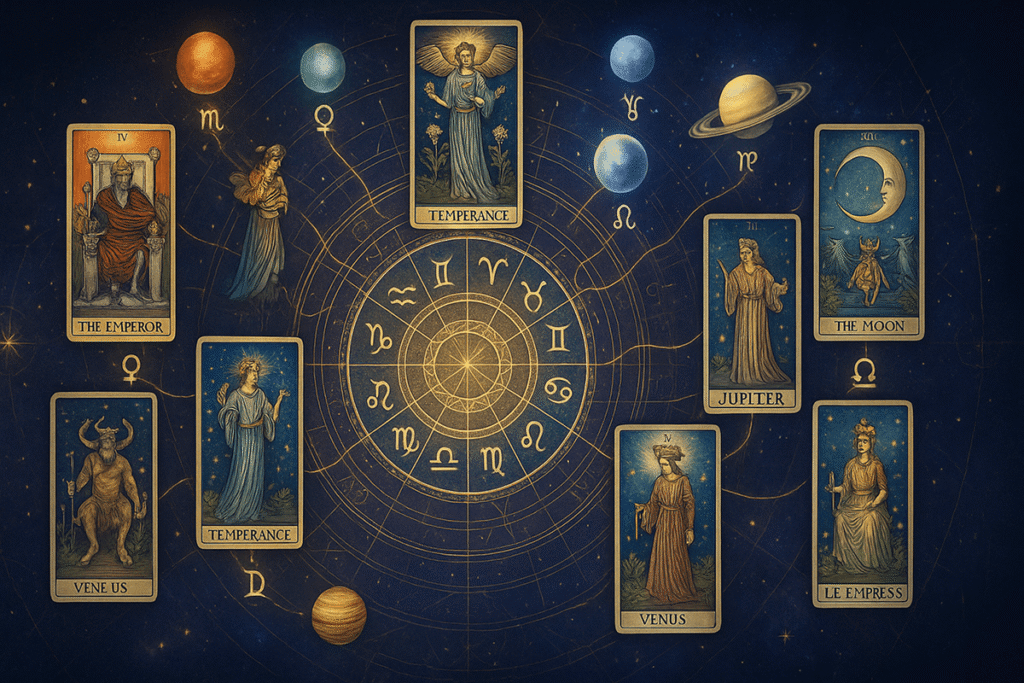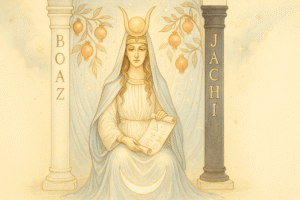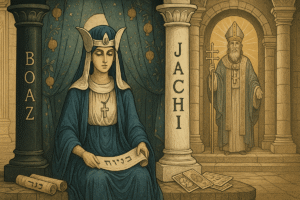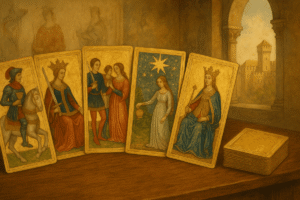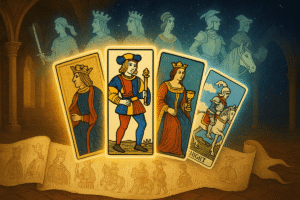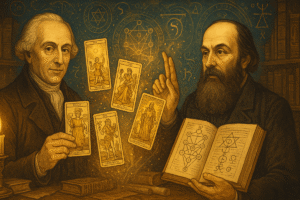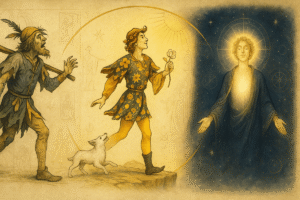Table of Contents
I’ll admit, when I first heard that each tarot card had its own astrological assignment, I was a bit skeptical. It felt like adding another layer of complexity to something I was already trying to wrap my head around. But the more I sat with this idea, the more it started to make sense. Not in a predictive way, mind you, but as a kind of symbolic language that helps you think about the cards from a different angle.
The system most people use today comes from the Hermetic Order of the Golden Dawn, a group of occultists working in late Victorian England. They took the tarot deck and mapped each Major Arcana card to either a planet or a zodiac sign. Some of the Minor Arcana got planetary assignments too, though those vary a bit depending on which tradition you’re following. What I find interesting is that this wasn’t meant to turn tarot into astrology. It was more about creating connections, building bridges between different symbolic systems so that each one could illuminate the other.
When you’re looking at a tarot card and you know its astrological correspondence, something shifts. Perhaps it’s easier to access certain qualities or moods associated with that card. The symbols start talking to each other, if that makes sense.
Understanding the Golden Dawn Framework
The Golden Dawn system is pretty structured, which I think helps when you’re trying to learn it. Each of the 22 Major Arcana cards gets assigned to either one of the seven traditional planets (the Sun, Moon, Mercury, Venus, Mars, Jupiter, and Saturn) or one of the twelve zodiac signs. The Fool, for instance, corresponds to Uranus in some modern interpretations, though traditionally it’s associated with Air as an element. The Magician links to Mercury. The High Priestess connects with the Moon.
There’s a logic to these assignments that becomes clearer the more you explore them. The Empress, associated with Venus, embodies themes of abundance, creativity, and sensuality. The Emperor gets Mars, which brings in structure, authority, and assertiveness. It’s not arbitrary, even if it might feel that way at first.
I think what makes this framework valuable is that it gives you another lens through which to view the cards. If you’re already familiar with astrology, even just a little bit, you can use that knowledge to deepen your understanding of tarot. And if you’re not, well, learning the astrological correspondences might actually help you learn astrology too. They feed into each other.
The Minor Arcana has its own system of correspondences, particularly the court cards and the numbered pip cards. The four suits often get linked to the four elements, which then connect to the triplicities in astrology. Wands align with Fire (Aries, Leo, Sagittarius), Cups with Water (Cancer, Scorpio, Pisces), Swords with Air (Gemini, Libra, Aquarius), and Pentacles with Earth (Taurus, Virgo, Capricorn). Some systems go further and assign specific degrees of the zodiac to each decan, dividing the numbered cards among planetary rulers.
It’s detailed work, perhaps more than you need when you’re starting out. But it’s there if you want to go deeper.
How Planets Shape the Major Arcana
Let me walk you through some of the planetary assignments in the Major Arcana, because this is where the system really starts to reveal its personality. Each planet in astrology has its own set of themes, energies, and associations. When you map those onto tarot cards, you’re essentially asking, “What does this planetary energy look like in archetypal form?”
The Magician corresponds to Mercury, the planet of communication, intellect, and skill. Mercury is quick, adaptable, and clever. It governs how we think, how we speak, and how we move through the world using our mental faculties. The Magician embodies all of this. He’s the one who takes raw potential and shapes it through will and technique. When you draw the Magician in a reading and you know it’s connected to Mercury, you might start thinking about how you’re using your words, your ideas, your ability to adapt.
The Empress gets Venus, which feels almost intuitive once you think about it. Venus is the planet of love, beauty, pleasure, and fertility. The Empress sits in a lush garden, surrounded by abundance. She represents creative power, nurturing, and the physical world’s pleasures. Knowing this Venusian connection might prompt you to consider how you’re engaging with beauty, comfort, or the act of creating something new in your life.
Mars goes to The Tower in many interpretations, though some traditions assign it to The Emperor instead. Mars is the warrior planet, associated with action, aggression, conflict, and sudden bursts of energy. The Tower, with its lightning strike and crumbling structure, captures that Martian quality of sudden disruption and forceful change. It’s not gentle. It’s not gradual. It’s explosive and immediate.
Jupiter corresponds to The Wheel of Fortune, which makes sense when you think about Jupiter as the planet of expansion, luck, and larger cycles. Jupiter is associated with growth, opportunity, and the kinds of changes that happen on a grander scale. The Wheel of Fortune speaks to cycles, fate, and the turning points in our lives. There’s a bigness to both.
Saturn gets The World in many systems, though some assign it to other cards depending on the tradition. Saturn is about structure, completion, mastery, and the kind of wisdom that comes only through time and experience. The World card represents completion of a cycle, achievement, and integration. It’s the culmination of a journey. That Saturnian energy of hard-won wisdom feels very present in this card.
I think these planetary correspondences work best when you use them as prompts for reflection rather than fixed definitions. They’re not meant to replace your intuition or personal connection with the cards. They’re just another tool in your kit.
Zodiac Signs and Their Tarot Counterparts
The zodiac signs each have their own corresponding Major Arcana card as well, and this is where things get really textured. Each sign has a particular quality, a mode of being in the world, and when you see that reflected in a tarot card, it adds dimension.
Aries, the first sign of the zodiac, corresponds to The Emperor. Aries is bold, initiating, assertive, and action oriented. The Emperor embodies leadership, authority, and the establishment of order. There’s a pioneering quality to both.
Taurus connects to The Hierophant in the Golden Dawn system. Taurus is grounded, traditional, and values stability and material security. The Hierophant represents tradition, spiritual teaching, and established systems of belief. Both have to do with what endures, what’s been passed down.
Gemini pairs with The Lovers, which is interesting because Gemini is the sign of duality, communication, and choice. The Lovers card is often about relationships, yes, but it’s also deeply concerned with choice, values, and the union of opposites. That Gemini energy of weighing options and seeking connection lives in this card.
Cancer, ruled by the Moon, gets The Chariot. This might seem odd at first because Cancer is often thought of as sensitive and home loving, but Cancer is also fiercely protective and emotionally driven. The Chariot is about willpower, determination, and moving forward despite obstacles. That protective, tenacious quality of Cancer shows up here.
Leo corresponds to Strength, and this one feels pretty straightforward. Leo is associated with courage, vitality, and inner power. Strength depicts a figure calmly taming a lion, representing mastery over one’s instincts and the quiet power that comes from inner confidence. Very Leo.
Virgo gets The Hermit, which resonates with Virgo’s introspective, analytical nature. Virgo is about discernment, service, and the quest for understanding through careful examination. The Hermit withdraws to seek wisdom, to refine his understanding. There’s a shared quality of thoughtful solitude.
Libra links to Justice, which is almost too perfect. Libra is the sign of balance, fairness, and relationships. Justice is about equilibrium, cause and effect, and making fair decisions. Both are concerned with harmony and right action.
Scorpio corresponds to Death, and before you get nervous, remember that the Death card is about transformation, not literal endings. Scorpio is the sign of deep transformation, regeneration, and the parts of life we’d rather not look at too closely. Death asks us to let go, to release what no longer serves, to make room for rebirth.
Sagittarius gets Temperance. Sagittarius is the seeker, the philosopher, always looking for meaning and broader horizons. Temperance is about balance, integration, and the blending of different elements to create something harmonious. There’s a shared quality of seeking higher understanding.
Capricorn corresponds to The Devil in the Golden Dawn system, which might surprise people. Capricorn is ambitious, disciplined, and concerned with material achievement. The Devil card often represents bondage to material concerns, limitations, and the shadow side of ambition. It’s a more complex correspondence, perhaps, but it invites reflection on how we can become trapped by our own desires for success or control.
Aquarius pairs with The Star. Aquarius is visionary, humanitarian, and concerned with the collective. The Star is about hope, inspiration, and a sense of connection to something larger than oneself. Both have an otherworldly quality, a sense of looking toward the future.
Pisces gets The Moon, which feels deeply appropriate. Pisces is intuitive, dreamy, and connected to the unconscious. The Moon card represents illusion, intuition, and the murky territory between the conscious and unconscious mind. Both deal with what’s beneath the surface.
Working With These Correspondences in Practice
So how do you actually use this information? I’ve found that the astrological correspondences work best as a starting point for deeper reflection rather than a rulebook. When you draw a card in a reading, knowing its astrological connection can help you access layers of meaning you might not have considered otherwise.
Let’s say you draw The Empress. You might initially think about nurturing, creativity, or abundance. But when you remember she’s connected to Venus, you might start asking yourself questions about pleasure, beauty, or your relationship with the physical world. What are you creating? What brings you comfort? How are you expressing love or receiving it?
Or imagine you draw The Tower and you know it’s associated with Mars. That Martian energy might help you think about what’s happening in terms of conflict, sudden action, or the need to break through something forcefully. It’s not just destruction for destruction’s sake. It’s Mars doing what Mars does, which is to cut through and move forward, even if that process is uncomfortable.
I think the key is to let these correspondences enhance your intuition rather than override it. They’re not meant to be prescriptive. You don’t draw The Empress and then try to force a Venusian interpretation if that’s not what you’re feeling. Instead, you let that knowledge sit in the background, available if it’s useful.
Some people find it helpful to journal about the astrological qualities of each card, exploring how the planetary or zodiacal energy shows up in the imagery, symbolism, and traditional meanings. Others might meditate on a card while considering its astrological ruler, noticing what thoughts or feelings arise. There’s no single right way to work with this system.
Why This Framework Still Matters
The Golden Dawn’s astrological correspondences have endured for over a century, which says something about their usefulness. I think they persist because they offer a coherent symbolic system that helps people think more deeply about the cards without being overly rigid. They give you a vocabulary, a set of associations that you can draw on when you’re trying to understand what a card might be inviting you to consider.
It’s also worth noting that this isn’t the only system of correspondences out there. Different traditions have assigned different meanings, and some modern readers develop their own personal correspondences based on their experience and intuition. The Golden Dawn system is just the most widely known and taught.
What I appreciate about learning these correspondences is that they’ve pushed me to think about tarot in a more multidimensional way. Each card isn’t just one thing. It’s a convergence of symbols, elements, numbers, astrological energies, and archetypal patterns. The more angles you have for approaching a card, the richer your understanding becomes.
And maybe that’s the real value here. Not that you’ll memorize every correspondence and apply them mechanically, but that you’ll start to see the tarot as part of a larger web of symbolic meaning. The cards don’t exist in isolation. They’re part of a conversation that’s been happening for centuries, drawing on mythology, astrology, psychology, and spiritual practice.
Whether you use these correspondences every time you read cards or just occasionally as a way to deepen your understanding, they’re there. A framework built by people who were trying to make sense of the same mysteries we’re still contemplating today.
Frequently Asked Questions
Why are there different astrological correspondences in different tarot systems?
Different tarot scholars and traditions have assigned different astrological correspondences to the cards based on their own experience and perspective. The Golden Dawn system is the most widely used, but variations exist in French occult traditions and other schools. No one system is superior to another, as long as your readings make sense to you. If you encounter conflicting systems, choose the one that resonates with your practice and stick with it until new insights suggest otherwise.
Do I need to memorize all the astrological correspondences to read tarot effectively?
There are wonderful tarot readers who don’t rely on astrological correspondences at all, so memorization isn’t mandatory for effective readings. Learning correspondences typically crystallizes slowly through repetition and familiarity rather than forced memorization. Start by becoming comfortable with the card imagery and meanings first, then layer on astrological knowledge gradually if it enhances your practice. The correspondences work best as tools to deepen understanding, not as rules to follow rigidly.
How can astrological correspondences actually help my tarot readings?
Understanding correspondences can help get your intuition unstuck when you’re drawing a blank on how a card fits within a spread. They add an additional layer of meaning that can refine the card’s interpretation in relation to the question. They’re particularly useful for pattern detection, such as noticing when multiple cards relate to Mars, suggesting potential conflict, or Jupiter, indicating expansion or excess. The correspondences give you another vocabulary and framework for thinking about the cards without being overly prescriptive.

